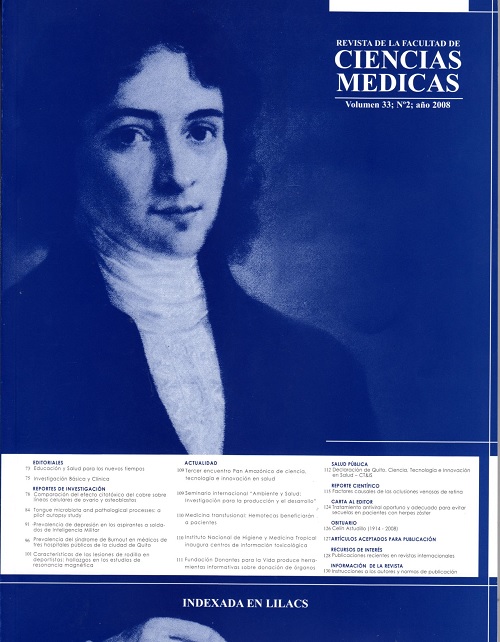Comparación del efecto citotóxico del cobre sobre líneas celulares de ovarios y osteoblastos
Resumen
Contexto: El cobre es empleado en su forma pura o como constituyente de aleaciones en biomateriales dentales y dispositivos intrauterinos (DIU) utilizados para la anticoncepción. .
Objetivo: Analizar el efecto citotóxico del cobre sobre las células UMR106 de origen osteoblástico y sobre las células ováricas de hamsters chinos (CHO K1).
Métodos: Se cultivaron células UMR106 y células CHO K1 en presencia de discos de cobre puro ubicados en el centro de las cápsulas utilizadas para cultivo, evaluando simultáneamente controles sin cobre. Se determinó el número de células vivas y muertas luego de distintas exposiciones entre 3 h y 72 h. Se midió la concentración de cobre liberado en condiciones similares en el medio de cultivo sin células después de distintos tiempos de inmersión.
Resultados: Se pudo constatar que en presencia de cobre el número de células muertas decrecía al aumentar la distancia cobre-célula y crecía con el tiempo de exposición, encontrándose ciertos tiempos y concentraciones umbrales por debajo de los cuales no se observaba efecto. Se notó también que la velocidad de reproducción celular decrecía en presencia de los iones metálicos evidenciándose un mayor efecto citotóxico en las líneas celulares de origen óseo.
Conclusiones: La exposición al cobre no reduce de manera importante el número de células vivas pero provocan cambios en la velocidad de reproducción en ambas líneas celulares.
Descargas
Métricas
Citas
2. Yap AU, Ng BL, Blackwood DJ. Corrosion behaviour of high copper dental amalgams. J Oral Rehabil 2004; 31:595-99.
3. Hujanen ES, Seppa ST, Virtanen K. Polymorphonuclear leukocyte chemotaxis induced by zinc, copper and nickel in vitro. Biochim Biophus Acta 1995; 1245: 145-52.
4. Grill V, Syrucci MA, Basa N, Di Lenarda R, Dorigo E, Narducci P, Martelli AM, Delbello G, Bareggi R. The influence of dental metal alloys on cell proliferation and fibronectin arrangement in human fibroblast cultures. Arch Oral. Biol 1997; 42: 641-47.
5. Kapanen A, Kinnunen A, Ryhänen J, Tuukkanen J. TGF-1 secretion of ROS-17/2.8 cultures on NiTiimplant material. Biomaterials 2002; 23: 3341-46.
6. Stea S, Visentin NM, Granchi D, Cenni E, Ciapetti G, Sudanese A, Toni A. Apoptosis in peri-implant tissue. Biomaterials 2000; 21: 1393-98.
7. Huk OL, Catelas IC, Mwale F, Antoniou J, Zukor DJ, Petit A. Induction of apoptosis and necrosis by metal ions in vitro. The Journal of Arthroplasty 2004; 19: 84-87.
8. Manzl C, Ebner H, Köch G, Dallinger R, Krumschnabel G. Copper, but not cadmium, is acutely toxic for trout hepatocytes: short-term effects on energetics and ion homeostasis. Toxicology and Applied Pharmacology 2003; 191: 235-44.
9. van Kooten TG, Klein CL, Kirkpatrick CJ. Cell-cycle control in cell-biomaterial interactions: expression of p53 and Ki67 in human umbilical vein endothelial cells in direct contact and extract testing of biomaterials. J Biomed Mater Res 2000; 52: 199-209.
10. Suska F, Gretzer C, Esposito M, Emanuelsson L, Wennerberg A, Tengvall P, Thomsem P. In vivo cytokine secretion and NF-B activation around titanium and copper implants. Biomaterials 2005; 26: 519-27.
11. Leonard SS, Harris GK, Shi X. Metal-induced oxidative stress and signal transduction. Free Radical Biology and Medicine 2004; 37: 1921-42.
12. Cortizo MC, Fernández Lorenzo de Mele M, Cortizo AM. Biocompatibility of osteoblast-like cells: Correlation with metal ions release. Biol Trace Elem Res 2004; 100: 151-68.
13. Bastidas JM, Mora N, Cano E, Pólo JL. Characterization of copper corrosion products originated in simulated uterine fluids on package intrauterine devices. J Mater Sci Mater Med 2001; 12: 391-97.
14. Cortizo MC, Fernández Lorenzo de Mele M. Cytotoxicity of copper ions released from the metal. Variation with exposure period and concentration gradients. Biological Trace Elements Research 2004; 102: 129-43.
15. Zhang C, Xu N, Yang B. The corrosion behaviour of copper in simulated uterine fluid. Corrosion Science 1995; 38; 635-41.
16. Mora N, Cano E, Mora EM, Bastidas JM. Influence of pH and oxygen on copper corrosion in simulated uterine fluid. Biomaterials 2002; 23: 667-71.
17. Xu T, Lei H, Cai SZ, Xia XP, Xie CS. The release of cupric ion in simulated uterine: New material nano- Cu/low-density polyethylene used for intrauterine devices. Contraception 2004; 70: 153-57.
18. Cai S, Xia X, Xie C. Corrosion behavior of copper/LDPE nanocomposites in simulated uterine solution. Biomaterials 2005; 26: 2671 – 76.
19. Locci P, Marinucci L, Lilli C, Belcastro S, Staffolani N, Bellocchio S, Damiani F, Becchetti E.Biocompatibility of alloys used in orthodontics evaluated by cell culture tests. J Biomed Mater Res 2000; 51: 561-68.
20. Craig RG, Hanks CT. Cytotoxicity of experimental casting alloys evaluated by cell culture tests. J Dent Res 1990; 69: 1539-42.
21. Granchi DG, Ciapetti G, Savarino L, Cavedagna D, Donati ME, Pizzoferrato A. Assessments of metal extract toxicity on human lymphocytes culured in vitro. J Biomed Mater Res 1996; 31: 183-91.
22. Bumgardner JD, Lucas CL. Cellular response to metallic ions released from nickel-chromium dental alloys. J Dent Res 1995; 74: 1521-27.
23. González M, Sloloneski S, Reigosa MA, Larramendy ML. Effect of dithiocarbamate pesticida zineb and its comercial formulation, azzurro IV. DNA damage and repair kinetics assessed by single cell gel electrophoresis (SCGE) assay on Chinese hamster ovary (CHO) cells. Mutation Research 2003; 534: 145-54.
24. Stewart PS. A review of experimental measurements of effective diffusive permeabilities and effective diffusion coefficients in biofilms. Biotech and Bioeng 1998; 59: 261-72.











